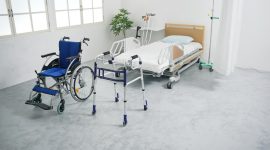Modern solutions in medical care – wheelchairs as rehabilitation tools
Wheelchairs are known to mankind for centuries. They are important rehabilitation tools that changed many lives. Nowadays it is impossible to imagine a world without them.
What is the role of wheelchairs?
Wheelchairs are a type of medical aid used by people with disabilities, as well as those with temporary injuries. They offer a substantial amount of support for people with severe mobility impairment. Modern wheelchairs are easy to maneuver and give the ability to ride in balance. They allow the users to drive in difficult terrain, overcome obstacles, climb and descend the slopes, and make quick turns. Additionally, modern wheelchairs can be quickly folded and placed in the means of transportation, which leads to a great improvement in the disabled person’s mobility and helps them achieve more independence.
How can wheelchairs facilitate the rehabilitation process?
Modern wheelchairs are customizable and can be adjusted to the individual needs of the users, which substantially facilitates the rehabilitation process and enhances the comfort of patients. Depending on the general state of the disabled person, their goals, needs, and preferences, the implemented solutions will vary. They will change in relation to the experienced symptoms – limited upper torso and hand function, limited head or neck mobility, or different symptoms of various other conditions – as well as the place and the manner of the wheelchair use, since navigation in small spaces calls for different equipment than mountain climbing. The most notable solutions that can greatly improve the wheelchair users’ comfort and safety consist of customizable seats and backrests, highly advanced brakes, and cutting-edge tires.
Seats and backrests
The seats and backrests of wheelchairs provide support and ensure the proper body position of the disabled person. They were designed to offer the range of backward arm movements and the ability to balance the torso. Modern wheelchairs use seats and backrests that can stop back pain, pressure sores, upper extremity injuries, as well as nerve and tissue damage. They help prevent aggravation of symptoms related to disability and as such facilitate the rehabilitation process.
Brakes
The implementation of modern brakes in wheelchairs improved their safety and positively affected the life of their users. Wheelchair brakes prevent unintentional movements, for example when the disabled person is traveling by a bus or a train. In this day and age there is a vast variety of brakes for wheelchairs to choose from, mainly:
- push-to-lock brakes, that work by a lever that is pulled or pushed to move a bar, which is then pressed against the tire and keeps it stationary.
- scissor brakes, which are attached to the frame and were designed for active users who use the tire and push ream to move forward,
- wheel hub brakes, which have a concealed lever that locks the wheel via the wheel hub instead of the tire and are perfect for people with less strength and limited reach,
- disc brakes, which can be applied independently and allow the wheelchair users to descend hills and lock wheels with just a slight touch,
- e-brakes, which are activated with a switch and lock both wheels simultaneously.
Tires
Modern wheelchairs use tires that offer maximum grip and prevent uncontrolled slipping. They can be chosen based on the intended use of the wheelchair. Currently it is possible to find tires for everyday use, but also for hill climbing or indoor sport activities. It allows more freedom for wheelchair users and affects their rehabilitation by improving their mental health.
The importance of robustness and safety for wheelchair parts and accessories
In order to offer comfort and facilitate the rehabilitation process, the wheelchair parts and accessories need to be robust and safe to use. That way they are resilient to the wear and tear and not prone to damage, which ensures long and injury-free exploitation.


